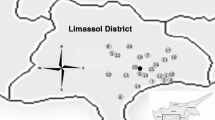Abstract
We studied 630 bacterial strains isolated from surface waters and determined as enterococci on the basis of their growth on Slanetz-Bartley agar in typical colonies. The strains were tested and characterized by several key conventional tests for basic differentiation of enterococci and by commercial test kits. We identified 135 strains ofE. fœcium (21%), 115E. fœcalis (18%), 30E. mundtii (5%), 27E. hirae (4%), 22E. casseliflavus (3%), 21E. gallinarum (3%), 17E. durans-E. hirae complex (3%), 5E. durans (1%), and 1 strain ofE. avium. 150 strains were classified only asEnterococcus sp. (25%) and 107 strains (17%) isolated from Slanetz-Bartley agar were not enterococci. We found that the non-enterococcal group consisted of other Gram-positive cocci and Gram-positive and Gram-negative rods. Based on the identification we tried to find a relation between taxonomic position of isolated strains and their colony morphology on Slanetz-Bartley agar. Out of the total of 523 identified enterococci, 345 strains (66%) formed purple colonies, 136 red colonies (26%), 37 pink colonies (7%) and 5 cream colored colonies (1%). There was no correlation among the color, size or colony morphology and the taxonomic characterization of enterococcal strains.
Similar content being viewed by others
References
Aguirre M., Collins M.D.: Lactic acid bacteria and human clinical infections.J. Appl. Bacteriol.75, 95–107 (1993).
Anonymous: Product Information. HiMedia Laboratories Pvt. Ltd., Bombay (India) 1991.
Barrow G.I., Feltham L.K.A.:Cowan and Steel's Manual for the Identification of Medical Bacteria, 3rd ed. Cambridge University Press, Cambridge (UK) 1993.
Collins M.D., Jones D., Farrow J.A.E., Kilpper-Bälz R., Schleifer K.H.:Enterococcus avium nom. rev., comb. nov.;E. casseliflavus nom. rev., comb. nov.;E durans nom. rev., comb. nov.;E. gallinarum comb.nov.; andE. malodoratus sp.nov.Int. J. Syst. Bacteriol.34, 220–223 (1984).
Collins M.D., Rodrigues U.M., Pigott N.E., Facklam R.R.:Enterococcus dispar sp.nov. a newEnterococcus species from human sources.Lett. Appl. Microbiol.12, 95–98 (1990).
Dever L.L., Smith S.M., Handwerger S., Eng R.H.K.: Vancomycin-dependentEnterococcus fœcium isolated from stool following oral vancomycin therapy.J. Clin. Microbiol.33, 2770–2773 (1995).
Devriese L.A., Collins M.D., Wirth R.: The GenusEnterococcus, pp. 1465–1481 in A. Balows, H.G. Trüperet al. (Eds):The Prokaryotes: A Handbook on the Biology of Bacteria, 2nd ed. Springer-Verlag, Berlin-Heidelberg-New York 1992.
Devriese L.A., Pot B., Collins M.D.: Phenotypic identification of the genusEnterococcus and differentiation of phylogenetically distinct enterococcal species and species groups.J. Appl. Bacteriol.75, 399–408 (1993).
Facklam R.R., Collins M.D.: Identification ofEnterococcus species isolated from human infection by a conventional test scheme.J. Clin. Microbiol.27, 731–734 (1989).
Facklam R.R., Sahm D.F.:Enterococcus, pp. 308–314 in R.R. Murray, E.J. Baronet al. (Eds):Manual of Clinical Microbiology, 6th ed. American Society for Microbiology, Washington (DC) 1995.
Facklam R.R., Wilkinson H.W.: The familyStreptococcaceae (medical aspects), pp. 1572–1597 in M.P. Starr, H. Stolp, H.G. Trüper (Eds.):The Prokaryotes, Vol. 2. Springer-Verlag, Berlin-Heidelberg-New York 1981.
Gordon R.E., Haynes W.C., Hor-Nay Pang C.: The genusBacillus, p. 14. in U.S. Dept. Agr., Agr. Handbook No. 427 (1973).
Herwaldt L.A., Wenzel R.P.: Dynamics of hospital-acquired infection, pp. 169–181 in R. R. Murray, E.J. Baronet al. (Eds):Manual of Clinical Microbiology, 6th ed. American Society for Microbiology, Washington (DC) 1995.
Jackman P.J.H., Phillips B.A., Farrow J.A.E., Painting K.A.:National Collection of Food Bacteria—Catalogue of Cultures 1990. NCIMB Ltd., Arbendeen Scotland (UK) 1990.
Jett D.B., Huycke M.M., Gilmore M.S.: Virulence of enterococci.Clin. Microbiol. Rev.7, 462–478 (1994).
Lauková A., Juriš P.: Distribution and characterization ofEnterococcus species in municipal sewages.Microbios89, 73–80 (1997).
Leclerc H., Devriese L.A., Mosse D.A.A.: Taxonomical changes in intestinal (fæcal) enterococci and streptococci: consequences on their use as indicators of fæcal contamination in drinking water.J. Appl. Bacteriol.81, 459–466 (1996).
Martinez-Murcia A.J., Collins M.D.:Enterococcus sulfureus, a new yellow-pigmentedEnterococcus species.FEMS Microbiol. Lett.80, 69–74 (1991).
Merquior V.L.C., Peralta J.M., Facklam R.R., Teixeira L.M.: Analysis of electrophoretic whole-cell protein profiles as a tool for characterization ofEnterococcus species.Current Microbiol.28, 149–153 (1994)
Pompei R., Berlutti F., Thaller M.C., Ingianni A., Cortis G., Dainelli B.:Enterococcus flavescens sp.nov., a new species of enterococci of clinical origin.Int. J. Syst. Bacteriol.42, 365–369 (1992).
Pourcher A.M., Devriese L.A., Hernandez J.F., Delattre J.M.: Enumeration by a miniaturized method ofEscherichia coli, Streptococcus bovis and enterococci as indicators of the origin of fæcal pollution of waters.J. Appl. Bacteriol.70, 525–530 (1991).
Ruoff K.L.:Leuconostoc, Pediococcus, Stomatococcus, and miscellaneous gram-positive cocci that grow aerobically, pp. 315–323 in R.R. Murray, E.J. Baronet al. (Eds.):Manual of Clinical Microbiology, 6th ed. American Society for Microbiology, Washington (DC) 1995.
Švec P., Sedláček I., Pakrová E.: Evaluation of the STREPOtest kit for the identification of enterococci isolated from human clinical material. (In Czech)Epidemiol. Mikrobiol. Immunol.45, 153–157 (1996).
Valdivia E., Martin-Sanchez I., Quirantes, R., Martinez-Bueno M., Galvez A., Maqueda M.: Incidence of antibiotic resistance and sex pheromone response among enterococci isolated from clinical human samples and from municipal waste water.J. Appl. Bacteriol.81, 538–544 (1996).
Author information
Authors and Affiliations
Rights and permissions
About this article
Cite this article
Švec, P., Sedláček, I. Occurrence ofEnterococcus spp. in waters. Folia Microbiol 44, 3–10 (1999). https://doi.org/10.1007/BF02816212
Received:
Issue Date:
DOI: https://doi.org/10.1007/BF02816212




